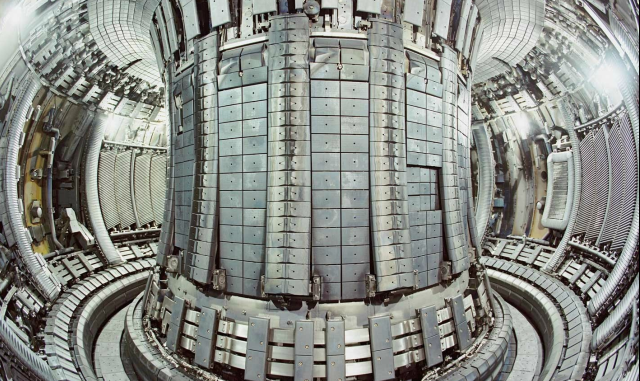
As world powers struggle to control climate change and negotiate a framework for reducing carbon emissions, a UK company has announced that it’s just five years away from achieving “reactor relevant” fusion.
Fusion is how stars produce energy NBC News explains:
It occurs when the nuclei of light atoms, such as hydrogen, are fused together under extreme pressure and heat.

BYPASS THE CENSORS
Sign up to get unfiltered news delivered straight to your inbox.
You can unsubscribe any time. By subscribing you agree to our Terms of Use
Tokamak Energy, from Oxfordshire, believes that the third version of their compact, spherical tokamak reactor will be able to reach temperatures of 100 million degrees Celsius by 2020. That’s seven times hotter than the center of the sun and the temperature necessary to achieve fusion.
Such a temperature fuses hydrogen atoms together, releasing energy, which differs from fission reactors that work by splitting atoms at much lower temperatures.
Fusion Power Getting Closer
Yahoo News reports:
In Paris world leaders are meeting to try to reach an agreed framework for action aimed at stabilizing atmospheric concentrations of greenhouse gases (GHGs). Governments hope the summit will end on December 11 in a deal that will herald a shift from rising dependence on fossil fuels since the Industrial Revolution to cleaner energies such as wind or solar power.
Key to Tokamak Energy’s success is the spherical shape of its tokamak – a device using a magnetic field to confine plasma – and thin high temperature superconductor strips.
“Here what we’re developing is building these small tokamaks, like ST25, and then we’ve got other devices using key technologies which are high temperature superconductors and spherical tokamak shapes,” senior Tokamak engineer Bill Huang told Reuters. “So we’ve got a slightly different shape from traditional fusion and this allows us to get a higher plasma pressure for a given magnetic field. It’s a measure of efficiency called beta, and by using this improved efficiency it means that the overall size of our device is actually quite a bit smaller.”
Tokamak Energy says its technology would be similar in costs to a nuclear fission plant, but without any fissile material and with no risk of meltdown.
The company, a World Economic Forum Technology Pioneer, says its compact design means fusion could be generated in far smaller reactors than assumed possible by scientists until recently.
Huang says that its current ST25 reactor has already reached fusion temperatures in short bursts, but hopes its third reactor, ST40 – currently being completed – will enable it to produce “reactor relevant” conditions.
“This (ST25) will allow us to get very high temperatures for a short amount of time but what we’re looking to do is generate these high temperatures which are reactor relevant, so we’ve set ourselves a 100 million degree challenge, and we’re aiming to get 100 million degrees in that (ST40) device,” said Huang.
The company is three stages into its five stage process – each involving a new reactor.
Tokamak CEO David Kingham believes it will be possible for his team to transfer energy to the grid by 2030.
“We want to get within five years to an energy gain, and from there we want to go on in ten years to get to first electricity, a device where we can demonstrate production of electricity from fusion, but it may be 15 years before we get energy to the grid in significant quantities,” said Kingham.
He added: “Fusion is one of those technologies which, if it could be harnessed, could be scaled up rapidly to be deployed world-wide by 2050 and could make a very big difference to carbon emissions and therefore to climate change from 2050 onwards.”
Tokamak Energy has developed its own magnets using novel high temperature superconductors and believes that this new material could be used to construct even more powerful magnets to keep the hot plasma in position inside a power generating tokamak, at the fusion reactor’s heart.
Edmondo Burr
CEO
Assistant Editor
Latest posts by Edmondo Burr (see all)
- Police Arrest Suspect In Supermarket Baby Food Poisoning - October 1, 2017
- Seoul Secures Data From Electromagnetic Interference By N Korea - September 30, 2017
- The ‘World’s First Internet War’ Has Begun: Julian Assange - September 30, 2017


The effort of controlled fusion has been on-going for over half a century, was at Los Alamos Lab when I first went there from Grad School , Sherwood Project. The joke in the effort, “Controlled fusion is only ten years away, and always will be.” But no “absolute” thing has been found to say it is impossible and it’s too soon to give up. Google the ITER, International Thermonuclear Experimental Reactor, has produced power for short periods of time. Fusion likely is Earth’s last hope. I doubt controlled fusion will happen in my lifetime, but I hope someday. kunosoura